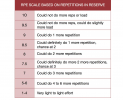You are using an out of date browser. It may not display this or other websites correctly.
You should upgrade or use an alternative browser.
You should upgrade or use an alternative browser.
Other/Mixed What does rpe/rate of perceived exertion mean
- Thread starter Hmmmm
- Start date
Other strength modalities (e.g., Clubs), mixed strength modalities (e.g., combined kettlebell and barbell), other goals (flexibility)
- Status
- Closed Thread. (Continue Discussion of This Topic by Starting a New Thread.)
Deleted 20758
Guest
RIR i easier to follow IMO.
Hung
Level 8 Valued Member
if you doing sets with 8-10 RM then it's okayRIR i easier to follow IMO.
For sets of < 5, I find it quite not the same. I can squat 130 kg x 1 quite easy, 135 x 1 feels a bit heavy and 140 x 1 sometime can be a grind...and that all RIR 1 for me.

I think this is the simplest one to look at. From - The Science of Autoregulation • Stronger by Science
Please give examples to better illustrate.
I'll be wordy here - alright, I'm almost always wordy - in the hope of a longish explanation providing some clarity.
My example would be almost any strength exercise I perform for repetitions. I aim for working sets to feel solid, crisp, under control but nonetheless challenging and requiring my full attention. To me that's an RPE of 8 and it correlates well with an 80% 1RM load in a strength exercise.
That's for strength. A ballistic:
After having finished my last powerlifting competition for a while, I've returned to swinging a kettlebell. When I was last swinging regularly about 3 months ago, I did 1h swings with a 28 or a 32, mostly the 28 and I was working the 32 into the mix. Now I've returned to swinging by using the 24 kg.
When I'm doing my swings, I'm aiming for perfection - I have a checklist of things that I want to improve and I'm continually picking one or two of those things to focus on. The fact that the weight is appropriate for my current training is indicated to me by several things, chief among them being that if I don't get something right, I notice but I don't get hurt. I have to pay attention to what I'm doing. I don't have to be fearful of the weight yet neither do I feel I can pay less than full attention. I do sets of 10 reps but I could certainly do 20 or 30 if I had to. A weight that's too light wouldn't let me feel the insufficient engagement of my lats as well, and it might find my mind starting to wonder also.
Those are all things that say RPE of 8 to me. I could swing the same weight with lower RPE by lessening some of what I'm doing - changing direction at the back more slowly, being less explosive to stand up, being less insistent on keeping my torso square to the front. They're still be OK swings, IMO, but RPE of 7.
Hope this is of some help. Much like PlanStrong advises doing most of one's training in the 70-80% zone, so I think we try to keep the RPE in that 7-8 out of 10 range most of the time.
-S-
Adachi
Level 7 Valued Member
Please give examples to better illustrate.
As a recovering novice - I was not well equipped to understand many explanations of RPE and how I could recognize it.
There are many good explanations out there that after some experience are more easily understood.
As a starting point, I like @Geoff Neupert 's explanation in Strength Shortcuts 2.0
e.g.
if you have a weight that you can do 10 reps with, maybe a 7/10 RPE is like how it feels to do 7 reps.
- OR -
If you have a weight that you can only lift once, maybe a 7/10 RPE is like how it feels to lift 70% of that weight once.
there will be some off days, or some easy days, which may be indicative of phases of adaptation or whether your sleep or diet is suffering. but, some correlation might be found by using this numerical interpretation.
maybe on average - most of the time - the descriptions of a 7/10 RPE should match pretty closely with lifting a 10RM weight 7 times. or a 5RM weight 3 or 4 times.
Excerpt from Strength shortcuts, below ...
Autoregulation: Using The RPE Scale For Managing Your Self And Your Training
Autoregulation is a method of training based on the feedback your body gives you before and during training. It’s a simple way to manage your training based upon your effort levels. And the best way to manage that is through using the RPE scale.
The RPE scale is a scale where you use determine your own effort levels and give them a numerical value (RPE = Rate of Perceived Exertion). Using a scale of 1 to 10 is the easiest, where 1 is drop dead easy, lying on the couch eating chips and watching Letterman and 10 is an all out full on max effort attempt. It also fits nicely when we are using RM percentages.
Here’s how I use it in my own training:
I simply try to match the number on the paper - the percentage - with my RPE.
I use it to try to gauge my how accurate my percentages are for that particular day. For example, if I’m lifting something that’s 70% of my max, I want my RPE to be a 7 or lower. Why? Because if it’s lower than a 7 then there’s a very good chance that it’s no longer 70% of my max - that it’s less than that, meaning I am getting stronger. And chances are pretty good that I’m going to push it that day - to try to increase the volume of work I can do, the density, or sometimes, I’ll even increase the load and see where the RPE and the load match.
If it’s 7, then I’m “flat” - fatigue or poor programming is inhibiting my strength gains or potential strength gains. And Heaven forbid that I’m an 8 - that means I’m probably tired, stressed, distracted, and I’m going to have to take it very easy and be careful. In fact, on those days I may just drop the reps, the load, or change to a similar, yet less demanding exercise. (From weighted chins to bodyweight chins for example.)
Here’s another example:
Let’s say I can press a pair of kettlebells 10 times. 70% would be 7 reps. Let’s also say that I decided that I was going to press them for 3 sets of 7 reps. Did all three sets match or the average of the three sets match a 7 out of 10, which would be an equivalent to 70% of your max?
For example, the first set was a 5. The second a 6. And the third a 7.
This would indicate that you’re adapting well and are probably “ahead of schedule” on being able to press a heavier pair of bells at your next test.
Conversely, if the first set was an 8, the second a 9, and you had to grind out the last set and called it a 10, then you’re not adapting well, and need to back off on your loading - decreasing either your frequency or your load.
And finally, if your first set was a 7, your second an 8, and the third a 8.5 or 9, you’re probably right on schedule.
We use the RPEs loosely - they’re not set in stone but they provide loose guidelines to help us from pushing too hard, too often.
Now I will admit, there’s a downside to using the RPE.
It requires that you keep a training log so you can record, measure, and monitor your progress, and more importantly, stay motivated by seeing your results.
Furthermore, and more importantly, it requires that you listen to your intuition and that you must be ruthlessly honest with yourself, neither over nor underestimating your abilities, mood, or state.
When you do this right, you can make rapid and near effortless progress in your training. Get it wrong, and you’ll be banging your head on the wall for years to
come either because of overtraining or injury. (Ask me how I know...)
silveraw
Level 9 Valued Member
Most people aren't if they have never practiced it.I was not well equipped to understand many explanations of RPE and how I could recognize it.
One thing that really helped me was breaking some of the SF rules every once in a while. Do a set and on the last rep decide what the RIR is. Then test it.
I've had sets that I thought were 2-3 RIR and turned out to be 5 when I was first trying to figure it out. It is a big switch from % based thinking and really gets into individual differences. Reload kind of touches on this a bit.
watchnerd
Level 8 Valued Member
Most people aren't if they have never practiced it.
One thing that really helped me was breaking some of the SF rules every once in a while. Do a set and on the last rep decide what the RIR is. Then test it.
I've had sets that I thought were 2-3 RIR and turned out to be 5 when I was first trying to figure it out. It is a big switch from % based thinking and really gets into individual differences. Reload kind of touches on this a bit.
I pretty much only use RIR for hypertrophy blocks.
Going for more reps on a moderately heavy set of 8 squats is very different from going for more reps on a very heavy triple.
- Status
- Closed Thread. (Continue Discussion of This Topic by Starting a New Thread.)


